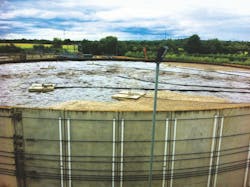About the author: Zeev Fisher is CEO of Mapal Green Energy. Fisher can be reached at [email protected] or +972.4.8200231.
The British water market was privatized more than 15 years ago and is managed today by more than 20 private water concessionaires, each having territorial responsibility for the water sector (water and sewage) in its region.
These private entities have a greater incentive to find methods and new technologies to reduce their O&M costs—mainly the energy costs in the aeration process—and improve profitability, as they are rigorously regulated by the government in both water quality effluent and prices.
The Stanbridgeford Wastewater Treatment Plant (WWTP) is operated by Anglian Water in the East of England region and provides water and wastewater treatment services to more than 6 million customers. It is situated in a rural location about 3 miles southeast of Leighton Buzzard, where it faced high energy costs due to excessive electricity consumption by the standard biological process in the plant, a traditional jet aeration system.
Prior to secondary treatment, the sewage flowed into a circular tank fitted with three jet aeration manifolds. The circular aeration tank had a daily flow rate of 3,400 cu meters per day in dry weather, with a design maximum flow to full treatment rate estimated at 10,000 cu meters per day in wet weather.
The air supply for the jet aeration system was provided by three rotary lobe blowers, located adjacent to the tank, where the treated sewage then was clarified by three final settlement tanks.
Since the plant was commissioned, the jet aeration system typically was shut down for four hours a day to save energy during peak cost periods.
Mapal Green Energy recently installed its floating fine bubble aeration system at the Stanbridgeford WWTP. The project aimed to save energy while maintaining or enhancing process performance to reduce biological oxygen demand (BOD), chemical oxygen demand and total suspended solids, and to increase dissolved oxygen. Another project goal was to demonstrate the effective yet simple features of the floating fine bubble aeration units.
Six floating aeration units were installed in the existing aeration tank alongside the old jet aerators, with no process interruption or harm to the surrounding area. Floating units were designed to be connected to the existing blowers through a separated manifold with isolating valve for each for easy maintenance and operation.
After commissioning, the system has achieved about 67% in energy savings, consuming 75 kW per hour, compared with 225 kW per hour prior to installation.
Air Flow Requirements
The fine bubble diffused aeration system sized for the current loads plus a 33% peaking factor would require a maximum airflow of 2,500 normal cu meters per hour, which easily falls within the capacity of one of the existing blowers. The uniqueness of the system is in the modularity and independent operation of each unit. It allows for better process control in terms of air flow rate control, adding more units if necessary to increase the air flow rate.
The maximum airflow required is 1,500 cu meters per hour, but the proposed airflow was rated to 2,500 cu meters per hour to provide sufficient and excessive aeration and mixing, if needed.
The proposed upgrade to the existing jet aeration system will supply a maximum airflow rate of up to 3,300 cu meters per hour.
The floating fine bubble aeration system achieved good results in terms of the process performance reduction in BOD parameters and ammonia control. The total BOD to be treated is 836 kg per day, and the ammonia that needs to be treated in order to meet the consent will be 111 kg per day.
Installation was fast and simple, and operation runs with no problems.
There also were no operational risks. The existing aeration system stayed in good operational condition and served as a standby system. Ongoing comparable monitoring by an independent consultant will publish results over the coming months.
Energy Saving Technology
In general, the aeration system can reduce up to 70% of the energy consumption in WWTPs, and reduce up to 80% of the maintenance costs. This is due to its method of using modular floating units that are levelled from the water surface instead of fixed to the concrete floor of the reactor. The floating system is based on fine bubble aeration instead of mechanical surface aerators, therefore removing the need to build a new reactor with a concrete floor.
When a WWTP decides to upgrade its aeration system from mechanical surface aeration, it typically has two options: Stop the process in order to drain the reactor for the installation works, which can take several months, or build a new reactor, which is a major capital expenditure investment.
The leading challenge faced today in water and wastewater treatment is the ability to save and create efficient energy consumption, which is mandatory, as energy consumption is an essential component in the O&M expenditure of water and wastewater treatment plants.
The floating fine bubble aeration system helps meet this challenge, and prevents the flow of untreated wastewater from reaching and contaminating the surrounding environment during shutdown for maintenance works or upgrading periods.
Download: Here
